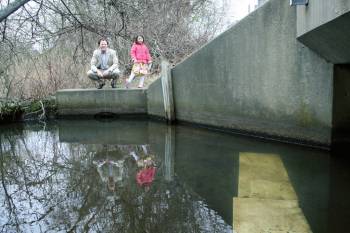 DRESSED FOR THE COUNT: On their return from church on Sunday, George Shuster and his daughter took 10 minutes to count herring in Buckeye Brook. They didn’t see any fish during their watch but dutifully recorded the water temperature and height.
DRESSED FOR THE COUNT: On their return from church on Sunday, George Shuster and his daughter took 10 minutes to count herring in Buckeye Brook. They didn’t see any fish during their watch but dutifully recorded the water temperature and height.
 DRESSED FOR THE COUNT: On their return from church on Sunday, George Shuster and his daughter took 10 minutes to count herring in Buckeye Brook. They didn’t see any fish during their watch but dutifully recorded the water temperature and height.
DRESSED FOR THE COUNT: On their return from church on Sunday, George Shuster and his daughter took 10 minutes to count herring in Buckeye Brook. They didn’t see any fish during their watch but dutifully recorded the water temperature and height.
Even the buckeyes know spring has arrived.
The first of the river herring were spotted March 14 and, says Paul Earnshaw, this looks like a strong run for Buckeye Brook, about three weeks sooner than usual.
Earnshaw, president of the Buckeye Brook Coalition, reports counts ranging from no fish to about 50 fish in a 10-minute span. Returning to their birth locations, the herring spawn in Warwick Pond and further upstream in Spring Green Pond, and then return to the bay and the sea.
Last year, volunteer fish counters recorded the best run since the coalition started keeping counts 10 years ago. It is estimated 54,800 fish returned during the run.
With the return of the buckeyes have come the volunteers. Earnshaw said, in addition to regulars, there are a lot of new faces for a total of more than 25 counters.
The count is taken at the Warwick Avenue culvert, where white sections of plastic extend across the streambed. The fish are easily seen as they swim over the markers on their way upstream. Counters stay on station for 10 minutes, then record the numbers plus the height of the stream and the temperature in a log kept onsite. The 10-minute count is multiplied by six to arrive at the hour’s total.
Edwards said for a first time counters are seeing smaller fish, believed to be two years old. These herring are five or six inches and have more vivid coloring than the adults of four and five years.
“Their backs are really black and sides very silvery,” Earnshaw said. He said he has talked with Phil Edwards, fisheries biologist for RIDEM, of the findings and “It’s got us both scratching our heads.” In addition to finding smaller than usual fish, Earnshaw said Edwards had also recorded some exceptionally larger herring – one measuring 13 inches – at other runs in the state.
The taking of herring from the runs, which used to be done by scooping them out of the stream with nets to use as bait fish, has been outlawed. Yet, as Earnshaw points out, trawlers are hauling them in by the thousands from known “hot zones” offshore, where they congregate before their spawning runs.
“We need to help them offshore and get the trawlers out,” Earnshaw said. He plans to address the New England Fishery Management Council meeting to be held Wednesday from 7 to 9 p.m. at the Hilton Garden Inn on Jefferson Boulevard. The council is considering amendments to the Atlantic herring management plan.
Earnshaw also said he is concerned by what he described as an extensive construction project, which he believes was taken on by a group of young people to dam the stream downstream from the Warwick Avenue bridge not far from the Assembly of God Church on Sandy Lane. He said this was a project that involved “intense labor” with the use of pressure-treated lumber and a large quantity of debris that had been hauled into the area. In addition to the dam, he said, they also found a large tree house.
“I had expected to find beer cans, but it wasn’t like that,” he said.
He said swastikas were painted on some trees and he thinks this wasn’t a typical party spot. The man who brought the situation to Earnshaw’s attention removed some of the dam. On Saturday, Earnshaw, accompanied by coalition members George Shuster and Carol Fritz, spent nearly another three hours breaking up the dam and pulling debris from the stream. With the assistance of volunteers, Earnshaw said he aims to complete the job and clear the area of debris during the Earth Day cleanup.